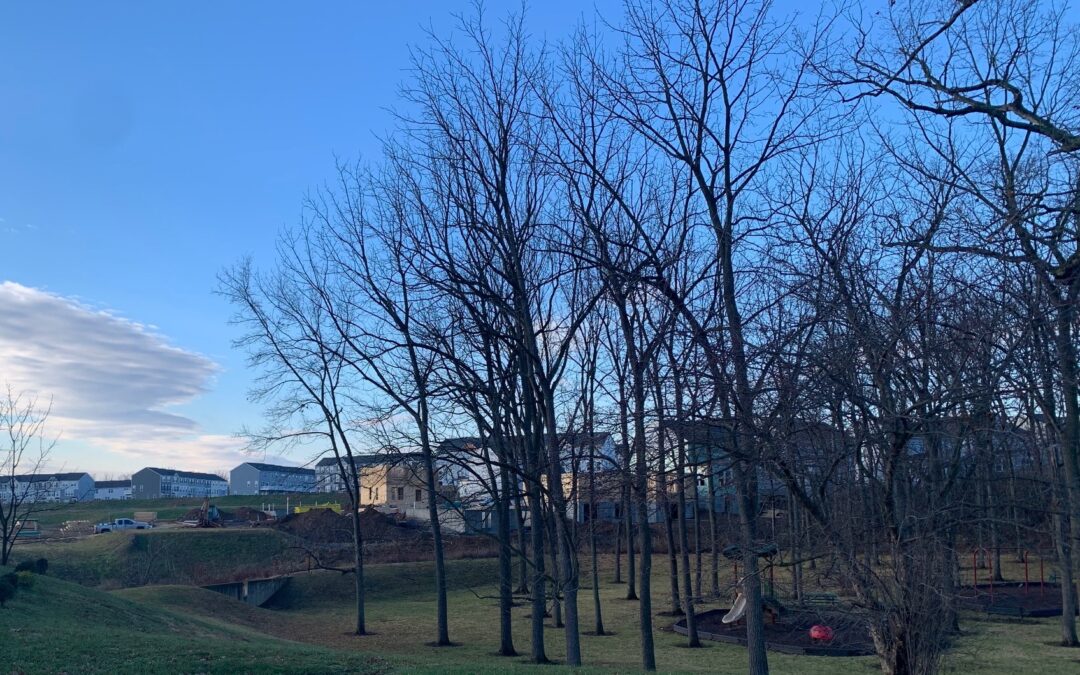Recently I walked down to our children’s playground here in West Virginia, where there is a small patch of trees, a bookhouse and some play equipment. Last year the area behind the playground was full of trees. It was a rural woodland. Trees covered about 10 acres with a cornfield or two. The accompanying picture shows that now the land has been developed for housing.
I have to say at the outset, that I have mixed feelings about the destruction of countryside and farmland to build houses. And yet, I also live, during the winter, in a condominium very similar to the ones pictured here. Also, I recognize that in many ways the dense use of the land for condominiums, or apartment buildings, is more efficient than the sprawling suburbs with larger houses accompanied by extended lawns that are popular everywhere.
There are, however, methods that we could encourage or even require, that would protect the soil and the environment for the future. Many of us think of the soil as if it were dead. We pave it over, dig it up, treat it with chemicals and ignore the importance of soil for our ecology.
One spring in northern Wisconsin I attended the annual birding festival in Ashland. During an event on salamanders (not birds), we all trouped into a wet woodland area and were instructed to dig into the soil. Salamanders! Lots of them were living just below the surface of the leaves. The children were transfixed and exploded with delight! Along with the salamanders were some frogs and other amphibians. I was very surprised to see all this activity just under the surface of the soil. I had no idea that this population of active animal life was just below our feet.
It was with great sadness that I have watched what the developers of this nearby housing project have done to the soil. First they cut down all the trees and brush and carried it away. Then they removed and shipped away all the topsoil. After that they opened up the ground with huge backhoes and stirred around the rocks. Presumably there were also sewer pipes and other infrastructure added at this time. Bulldozers designed the roads and the concrete was laid down. By then, nothing could be alive in the soil. They added chemicals to prevent the possibility of termites from interacting with the new houses. Then houses were started and constructed. A few trees were planted and people began to move into new residences.
Any animals that could walk or fly certainly moved away. All the deer, foxes, rabbits, squirrels and birds probably had a few days to move to some other area. I’m not sure about the smaller reptiles and amphibians. Some of the snakes probably managed to get to safety, but not the salamanders and frogs, the milkweed roots, the algae, the worms and the fungus. Much of the life inside the earth was ground up and chemically exterminated.
There is probably a less destructive way to build houses, but because we think the earth is a “dead” space, we don’t explore better ways to protect it. Much of what we do now depends on large equipment to move and overwhelm the soil. I feel sure that early American settlers did not turn the soil 30 feet under when they built houses. After all, most of what they did was completed with hand shovels and axes.
Our successful technology has allowed us to tame and overpower the natural world. Now fields that have been agricultural for over two hundred years, that we are learning are not really “natural,” are being further developed for roads and buildings.
I look out my back window and see the cows next door and wonder when the owner will sell his land to another developer. Our conservationists are not able to work fast enough, nor do they have enough money, to protect our environment and construct a healthy plan for the future.
What suggestions do you have? How should we steward the land and protect it for our grandchildren and their grandchildren? What is “progress?”


